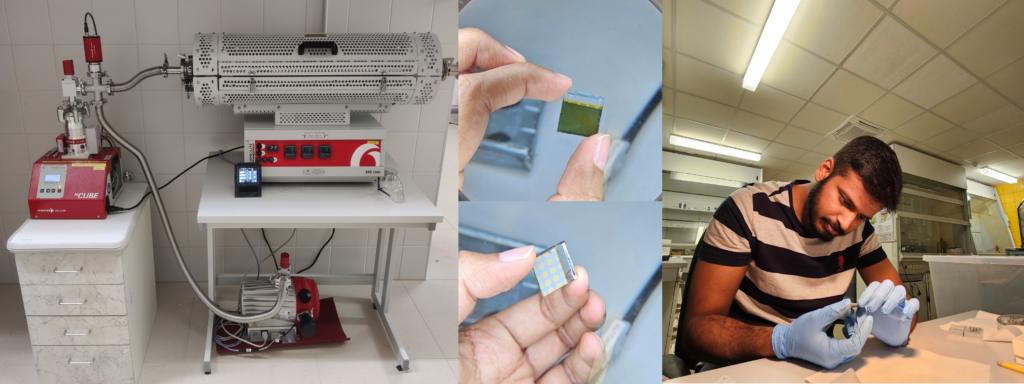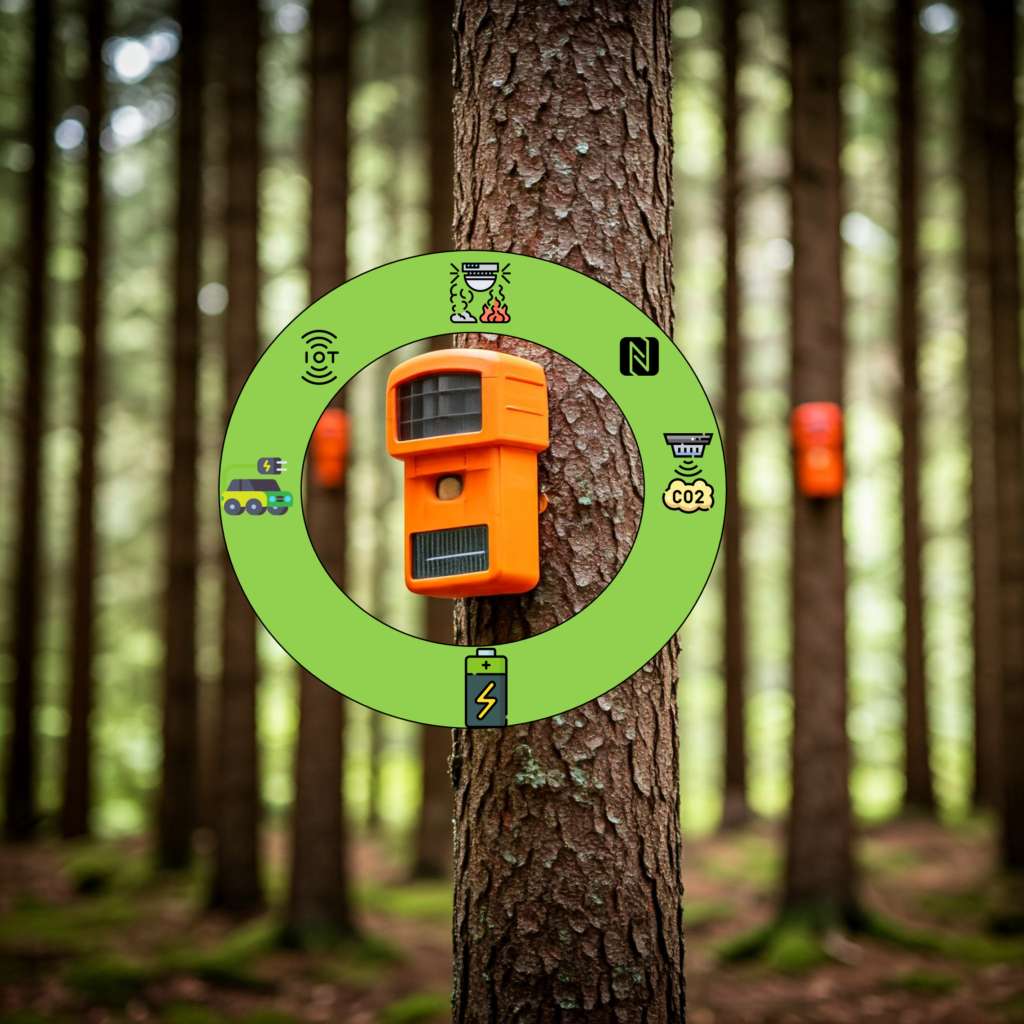Table of Contents
While it’s impossible to eliminate forest fires, early detection plays a crucial role in minimising their impact. Next-generation solar cells developed at Tallinn University of Technology (TalTech) could offer a solution by providing continuous monitoring of forests. These advanced solar cells have the potential to power fire detection systems in remote areas, enabling faster response times.
Wildfires in Focus: Understanding the Crisis and Its Obstacles
The climate crisis, once dismissed as a distant threat, has become an undeniable reality, with a profound impact on our environment. Among the most devastating consequences is the alarming increase in forest fires across the globe, driven by rising temperatures and changing weather patterns. Humans are responsible for accelerating this crisis, and our forests are paying the price.
Recent studies have shown that global warming is fueling a surge in forest fires, with incidents on the rise worldwide. These fires not only wreak havoc on the environment but also pose a dire threat to wildlife. Many species, already struggling to survive, are being pushed closer to extinction as their habitats are consumed by flames. Even in Estonia, last summer saw a spike in forest fires, prompting authorities to urge citizens to exercise caution and avoid actions that could ignite a blaze.
It is worth emphasising that there are methods to mitigate the widespread destruction caused by these fires. Advances in technology have provided effective tools to combat forest fires, ranging from planes that can douse large areas with water to specialised firefighting teams.
However, the challenge lies in early detection. While it’s currently impossible to prevent forest fires altogether, due to the unpredictable nature of factors like temperature, wind, and human activities, early detection plays a crucial role. Without it, fires can spread rapidly, causing immense damage before help arrives, especially in remote forest areas.
This tragic scenario has played out in recent years in places like Canada and Australia, where delayed responses to forest fires have led to devastating losses of both land and wildlife. By improving our ability to detect fires early, we can respond more swiftly and reduce the impact of these destructive events, protecting both our forests and the creatures that call them home.

Solar Tech: A New Tool for Wildfire Prevention
To tackle the growing threat of forest fires, we need innovative solutions that can outpace the flames. One promising approach is to use satellite technology to monitor forests constantly. Geostationary satellites have been instrumental in weather prediction and disaster prevention for decades and, can continuously monitor vast forest areas. This real-time data could help us anticipate fire-prone conditions and take action before it’s too late. However, spotting a fire in the dense, remote corners of a forest remains a significant challenge.
This is where the idea of deploying on-the-ground forest fire detectors comes in. Consider a network of small, intelligent devices scattered throughout the forest, each equipped with sensors that can detect early signs of fire. These sensors include CO2 detectors, smoke sensors, and temperature monitors, all designed to pick up the first hints of a fire. When a potential fire is detected, these devices would immediately send an emergency SOS signal to authorities, with the exact location of the fire. This rapid response capability could make the difference between a small, manageable fire and a full-blown disaster.
But there’s a catch: how do we power these devices? Traditional batteries would need regular replacements in the sprawling, remote forests, which poses a logistical nightmare. The answer lies in harnessing solar energy. Solar-powered fire detection systems could operate autonomously for years, with minimal maintenance. These solar cells would keep the sensors running day and night, ensuring that the devices are always ready to detect the first signs of danger.
Solar cells, which allow us to harness electricity directly from sunlight, have long been hailed as a cornerstone of renewable energy. As a sustainable and environmentally friendly source, solar power offers the promise of endless energy, as long as the sun shines. However, the technology behind solar cells was once prohibitively expensive, largely due to the complex process of producing the materials they rely on.
Traditional solar cells are primarily made from silicon, a material derived from abundant sand, yet requiring a significant amount of energy for purification to the level needed for efficient electricity generation. This purification process has historically driven up the cost of solar cells, making widespread adoption challenging.

Next-gen solar cells from Taltech
In recent years, however, there have been significant advancements in the production of silicon, leading to a dramatic drop in the price of solar cells. This has made solar energy more accessible than ever before, paving the way for broader use worldwide.
At the same time, scientists have been pushing the boundaries of solar technology by developing what’s known as second-generation solar cells, commonly referred to as thin-film solar cells. These include types such as cadmium telluride, kesterite, and perovskite solar cells, all of which offer potential advantages over traditional silicon. For example, they have lower production costs or generate electricity in lower light conditions, expanding the possibilities for renewable energy use.
Among these, cadmium telluride solar cells have already made their way into commercial use, thanks to their relatively low production costs and good efficiency. However, some of these new materials face challenges, including toxicity, and scarcity of raw materials. These hurdles have slowed their widespread adoption.
Antimony chalcogenide solar cells, represent the latest innovation in the quest for better solar technology. These new cells have shown promise in overcoming many of the issues that plague other thin-film technologies. Antimony chalcogenide is a safer and sturdier material, addressing some of the key barriers to commercialisation.
While researchers continue to improve the efficiency of these cells to rival that of traditional silicon, this new technology already shows promise for low-energy applications. An exciting feature of antimony chalcogenide solar cells is their ability to generate electricity even in low-light conditions. This attribute makes them particularly well-suited for environments with less intense sunlight, thus extending solar power’s reach to new areas. Additionally, these cells are simpler to manufacture compared to their silicon counterparts, potentially reducing costs even further.

Since 2021, as a PhD student in TalTech’s Laboratory of Thin Film Energy Materials, I have been developing antimony selenide solar cells alongside my colleagues. Our lab primarily focuses on the research and development of antimony chalcogenide solar cells through cost-effective and practical production methods, achieving practical efficiencies of 5–9%.
While this may seem modest compared to traditional solar cells, it is more than sufficient for powering low-energy devices, such as those used in the IoT. But we are ready to go beyond small-scale applications and are already exploring how these solar cells can be integrated into buildings and flexible devices, pushing the boundaries of where and how solar energy can be used. Our next step is to apply these solar cells to forest fire detectors.
Antimony chalcogenide solar cells also boast impressive longevity. They have a long operational life with minimal degradation in performance, making them ideal for deployment in remote forest areas where regular maintenance is challenging. This durability lowers maintenance costs and increases reliability, both crucial for forest management authorities.

The vision of Taltech team
This approach tackles the urgent need for early fire detection while supporting the shift to sustainable, renewable energy solutions. With solar power, we minimise the environmental footprint. At the same time, we safeguard our forests and wildlife, creating a win-win for the planet. In the face of increasing global temperatures and more frequent wildfires, embracing such technologies could be a crucial step toward safeguarding our natural landscapes for future generations.
At TalTech, my colleagues and I believe that our planet isn’t just for us; it’s also home to countless species and ecosystems that deserve protection. As we strive to use nature’s resources wisely, we also bear the responsibility of safeguarding our environment. This innovative approach to forest fire detection, powered by solar cells, represents a significant step in that direction. By harnessing cutting-edge technology, we hope to make a meaningful contribution to the preservation of our forests and the diverse wildlife that depends on them.
Author of this article is Sajeesh Vadakkedath Gopi from TalTech. Editor Jaan-Juhan Oidermaa. Article written for the contest “Science in 3 minutes” organised by Estonian Academy of Sciences and The Estonian Young Academy of Sciences (EYAS). Main sponsor of the competition is Inclusive Financial Technology Foundation.
If this glimpse into engineering and technology has sparked your curiosity, don’t short-circuit now – gear up for our next article where innovation meets inspiration! Read more about Energy-Efficient Icebreaking Technology!
 Back
Back



